Creative Catalyst
LCGC Europe
Keith Bartle, Emeritus Professor of Physical Chemistry and Visiting Professor in the Energy Centre of the University of Leeds, UK, has been a creative catalyst in a wide range of chromatographic collaborations stretching from the analysis of methane in air to printing inks. He spoke to Caroline West from the University of Orléans, in Orléans, France, about his career in chromatography and his proudest scientific achievements in separation science, including his research in supercritical fluid chromatography (SFC), gas chromatography (GC), and “the unified chromatograph”.
Keith Bartle, Emeritus Professor of Physical Chemistry and Visiting Professor in the Energy Centre of the University of Leeds, UK, has been a creative catalyst in a wide range of chromatographic collaborations stretching from the analysis of methane in air to printing inks. He spoke to Caroline West from the University of Orléans, in Orléans, France, about his career in chromatography and his proudest scientific achievements in separation science, including his research in supercritical fluid chromatography (SFC), gas chromatography (GC), and “the unified chromatograph”.
Caroline West: When did you first become interested in chemistry and what was the appeal?
Keith Bartle: At school I was actually directed towards the classics: a narrow escape! I was fascinated by the idea of chemical change. How did the coal in the firebox of the Thames–Clyde Express railway engine passing and shaking my home become converted to energy? How was Bakelite, an early polymer, made? How was oil of wintergreen, a remedy for backache, extracted from a plant? It was all so preferable to conjugating Latin verbs and quoting Roman emperors. Rudimentary apparatus and a surprising range of chemicals could be bought by post at that time - so there were a number of narrow escapes there too!
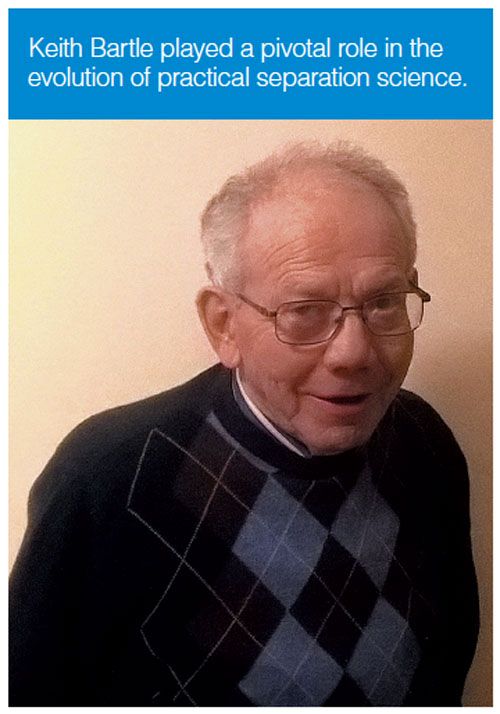
CW: Did you have a mentor who inspired you and guided you towards separation science?
KB: My Ph.D. work was in nuclear magnetic resonance (NMR) spectroscopy, but inspired by Denis Desty (BP, Sunbury, UK) and Marcel Golay (PerkinElmer, Norwalk, Connecticut, USA), I had long been interested in the high resolution offered by capillary gas chromatography (GC). This led to an association dating from 1968 with Milos Novotny (Indiana University, Bloomington, Indiana, USA) and later with Milton Lee (Brigham Young University, Provo, Utah, USA). Peter Myers (University of Liverpool, Liverpool, UK) has always been a strong and supportive influence. But the decision to work with supercritical fluids (SFs) was because of my Head of Department, Peter Gray, who perceptively encouraged Tony Clifford (both University of Leeds, Leeds, UK) to use his formidable knowledge of physical chemistry to supply the theoretical back-up for the work that encompassed supercritical fluid chromatography (SFC), extraction, and reactions in supercritical fluids. Tony and I cooperated for many years and because of him our work was always rooted in sound science (1–3).

CW: When you started working in chromatography, I suspect that you built your own systems because no commercial systems would have been available. When did you see chromatography transforming from an art into science?
KB: Back in the early days of chromatography there was great confusion over column technology. High-performance column packings for liquid chromatography (LC) were only just coming on stream - but were quickly adopted - and people like Peter Myers, who were active in this area, actually revolutionized separation science by making available high-resolution high perfomance (HP)LC columns that provided repeatable and reproducible separations. The manufacture of reliable (then glass) capillary columns for GC proved more difficult, spawning a vast, sometimes contradictory literature: too-often based on anecdote, rather than any firm grasp of the underlying science. The advent of fused silica and the subsequent defining of the chemistry and physics of coating fused-silica columns changed all that.
CW: For my part, I have always found that a bit of ignorance was useful when going in a new direction, because it helps accepting new observations without preconceptions. It must have been an exciting era to start supercritical fluid chromatography when nothing had been done before. How did you progress in this direction?
KB: Yes, in fact SFC was suggested (4) as early as 1957 by James Lovelock and was demonstrated by Ernst Klesper in 1962 (5) as a way of making use of the favourable properties of supercritical fluids as mobile phases, such as high densities (leading to greater solvent power), low viscosities (allowing low pressure drops), and faster diffusion (producing greater chromatographic efficiency), but our first SFC separations used conventional HPLC columns. We were completely in the dark, not knowing what would happen. Would the homeâbuilt chromatograph separate a test mixture? Would it explode? We remembered that supercritical fluids were compressible! We retired behind safety shields and waited, and were rewarded by a respectable chromatogram, which made us keen to persist. But it could have all gone “pear-shaped” and I would have had to return to the NMR lab!
CW: As a university professor, you must have been widely solicited with many teaching and administrative duties, in addition to research. Did you find it hard to find the balance between research and university duties?
KB: I found there are two cardinal rules here! First, always do your teaching to the absolute best of your ability. I have done my share - much of it in the teaching laboratories I was responsible for - and look back on this with great affection. Second, try to minimize the time you spend in meetings. Ask yourself whether you need to be there and also whether what is being talked about is outside the “circle of control”. It is unlikely that the government will respond to complaints voiced at chemistry department staff meetings, however well justified! Additionally, I always tried to multitask, occasionally with unforeseen results. For example, I sometimes overdid my timeâsaving modus operandi of holding “walk and talk” discussions while moving down the corridor and this led my students to provide me with a Doppler effect T-shirt: on the front, the slogan “Blue Shift:Approaching”, on the back “Red Shift:Receding”. I took the hint. Networking is vital though: I know sabbaticals are difficult these days, but do try to travel. I heard John Phillips (Southern Illinois University, Carbondale, Illinois, USA) introduce two-dimensional GC (GC×GC) at a meeting in the USA. The subsequent development and application of this method by Ally Lewis in the atmospheric chemistry programmes first at Leeds and then at the University of York proved groundbreaking and absolutely invaluable.
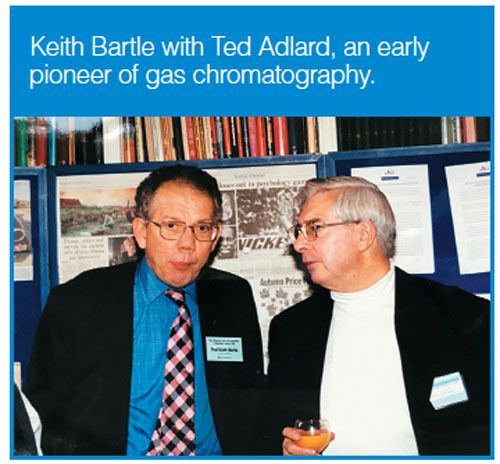
CW: In the current state of chemistry, analytical chemistry, and chromatography in particular, is often considered as the poor relative by other branches of chemistry. Perhaps this is because education in separation science is faulty in many universities around the world. As a professor and researcher, how did you try to transfer your knowledge and passion for separation science?
KB: Yes, the “other chemists” can be very irritating! My response is to tell them to try doing whatever they do without separation science, then drink up and leave, consoling myself with recent remarks by medicinal chemist Derek Lowe (6): “Chromatography hasn’t just made organic chemistry easier, in most cases it makes it possible.” In really annoying situations you can, as an example of chromatographic science, ask critics for their views on Professor John Knox’s papers on band broadening (7). As for my efforts, I hope I did my bit for chromatography by helping to initiate the Leeds chemistry with analytical chemistry degree course, which was heavily biased towards separations, and by teaching several component modules. And many of my graduate students have gone on to senior posts in the UK and elsewhere. But I have to say that chromatographers are not always entirely their own best friends, as shown by the unseemly quarrel, thankfully now all in the past, between exponents of packed and capillary columns for SFC.
CW: Can you describe your relation to students in the laboratory? Did your students’ interests influence your projects?
KB: Well, they were all different, but I tried to make sure they were clear about the goals of what they were doing. I never believed in micromanagement but positively encouraged independence and indeed serendipity. One example is Daixin Tong’s independent work on packing microcolumns (8,9), which underpinned our later work in unified chromatography (10–12) and also our capillary electrochromatography programme (13,14). Students always knew that if they had results to show I would do my best to get them to (usually) highly enjoyable conferences.
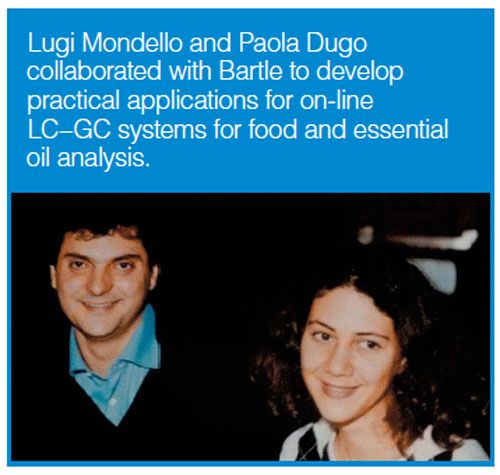
CW: In the current state of academic research, state funds are scarce and most scientists must rely on industry contracts. Did you have connections with industries to develop your research?
KB: One way or another most of our work was funded by industry. You see, I was always encouraged by the retort of the Roman Emperor Vespasian: “Pecunia non olet” (“money has no odour”). Also, by Louis Pasteur’s definition: “There are no such things as applied sciences, only applications of science”. Examples from the many diverse applications of science by our group would include the extraction and analysis of anti-cancer drug precursors from yew needles (15); the determination of additives and oligomers in PET polymers by supercritical fluid chromatography Fourier-transform infrared spectroscopy (SFC-FTIR) (16); and the establishment of the role of unburned fuel in emissions from diesel engines.
CW: In the 1980s, SFC found a variety of applications: pharmaceuticals (17), natural products (18), polymers and additives (19). Then, it was partly abandoned by a vast majority of academics and users to remain essentially present as a preparative technique for enantioresolution in the pharmaceutical industry. Today, the application fields open up again as interest is aroused by the introduction of modern, robust analytical systems. What other fields would you find interesting to investigate with SFC now?
KB: Of course, we need much more practical activity in the pharmaceutical industry. To do this we need to improve all of the resolution, selectivity, and sensitivity issues. It seems that mass spectrometry (MS) is developing at breakneck speed and its impact on separation science - always significant - will grow even more in the near future as techniques such as Fourier transform ion cyclotron resonance mass spectrometry (FT-ICR-MS) and two dimensional mass spectrometry (2D MS) develop. In fact, I have even heard it suggested that MS may even replace chromatography! But, like Mark Twain, “I suspect that rumours of its demise are probably exaggerated!” At the end of my lecture courses I always advised students that, whatever else they did, they should listen to the MS people. Meanwhile, I would like to work to maximize the opportunities offered by SFC–MS, and also pursue the advantages of the new robust unified instrumentation. When we began work in SFC we found that with the equipment available at the time, pressure regulation, control of mobile phase composition, and reliability were insufficient for routine use. In 1981, however, Milos and Milton realized that SFC could be performed on capillary columns in conventional chromatographs in what was an extension of GC. The modern unified instruments with packed microcolumns take account of the advantages of all chromatographic modes and have small flow rates (and are hence “green”) and peak volumes.
CW: If you were a beginner in separation science today, what field would you find most inspiring? What would you most like to investigate?
KB: There are many fields I find inspiring. I would like to explore the expansion of “open-access” SFC. Increasingly, a specialist analyst is not required. I would also look at improved SFC separations for chiral compounds. Richard Ansell (University of Leeds) has found molecular imprinted polymer stationary phases very promising in this area (20) and size-exclusion chromatography (SEC) should also be investigated further. SEC has lagged and we need to improve it by making use of the new stationary and mobile phases. We also need an improved understanding of SFC retention near the critical point and the effect of additives. The new generation of instruments (and chromatographers!) make this an exciting time for chromatography research. Multidimensional chromatography will be driven by analytical necessity, but 2D LC×LC is very promising; outstanding results have been obtained here by Paola Dugo of the University of Messina, in Italy (21).
CW: If you could change something in your scientific path, what would it be?
KB: I should have listened to my mentors: to Milos Novotny and learned some biology; and to Peter Myers and learned some more surface chemistry!
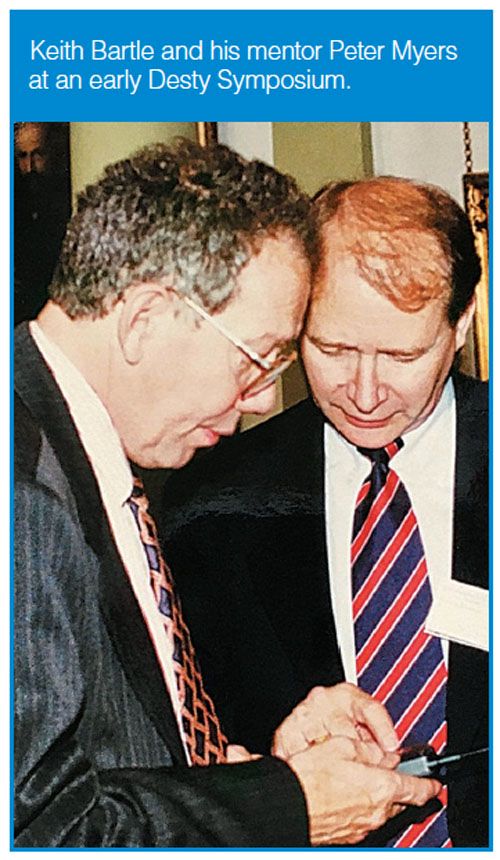
CW: What would you qualify as your most significant contribution to separation science? What research are you most proud of?
KB: Three specific collaborations, perhaps, gave me most pleasure, much of it because of the people involved. I worked with Milton Lee on research to understand the coating of fused-silica capillary GC columns (22). I worked with Luigi Mondello and Paola Dugo (from the University of Messina, Messina, Italy) on a project to develop methods using coupled LC–GC. In on-line LC–GC, high resolution LC fractions are transferred to a capillary GC column for further separation; it has become the method of choice, for example, in essential oils, and in detecting adulteration of olive oils. Luigi Mondello has published an excellent review on this topic (23).
I have also worked with Bob Robinson, Tony Edge, Mark Raynor, and Daixin Tong (all University of Leeds) in constructing “the unified chromatograph” (10–12). The versatility of this instrument was made clear in the operation of the system in so-called “enhanced fluidity” or variable temperature mode with a (programmable) mixture of eluent starting with CO2 as the initial mobile phase - and hence operating in SFC mode - then programming all the way to the polar liquid phase, that is, to HPLC. There were two important findings here: the importance of solubility in determining retention, and the enormous selectivity resulting from the variation of pressure, temperature, and mobile phase composition.
And I always had the benefit of Tony Clifford’s firm grasp of physical chemistry, and the enthusiasm of Peter Myers: “C’mon Keith, we can do that” he would say!
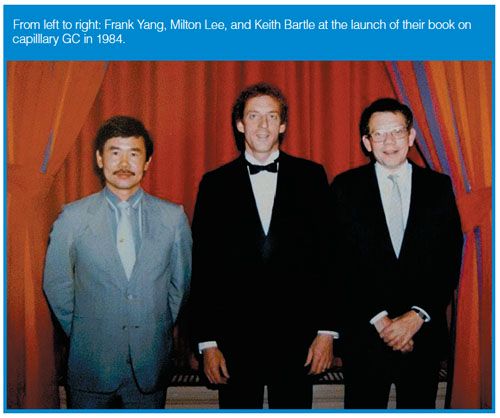
CW: Do you have any advice for any younger separation scientists embarking on a career in separation science?
KB: First, and most important, always remember Derek Lowe’s comment that I mentioned previously. What you do is important! While making full use
of established techniques be aware of developments in new areas - such as coupling to MS, comprehensive multidimensional methods - and be prepared for the possibility that a less familiar approach may be just the solution for a specific problem. For example, GC with atomic emission (AE) detection for the analysis of toxic emissions from landfill sites (24); Peter Myers’s electric field gradient focusing for protein separation (25); Ally Lewis’s GC on a chip (26); and Tony Clifford’s determination of solubilities in superheated water chromatographically (27).
References
- K. Barker, K.D. Bartle, and A.A. Clifford, Chem. Eng. Commun.68, 177–184 (1988).
- K.D. Bartle, A.A. Cliford, D. Mills, and R. Moulder, J. Chem. Soc. Faraday Trans I 25(8), 2347–2353 (1989).
- K.D. Bartle, A.A. Clifford, S.A. Jafar, and G.F. Shilstone, J. Phys. Chem. Ref. Data20(4), 713–730 (1991).
- J.E. Lovelock, paper presented at the 132nd American Chemical Society Meeting Symposium on Advances n Gas Chromatography, 1957.
- E. Klesper, A.H. Corwin, and D.A. Turner, J. Org. Chem. 27, 700–706 (1962).
- D. Lowe, Chemistry World24(12), 24 (2014).
- J.H. Knox, J. Chromatogr. 831(1), 3–15 (1999).
- D. Tong, K.D. Bartle, A.A. Clifford, and A.M. Edge, J. Microcol. Sep. 6(3) 249–255 (1994).
- D. Tong, K.D. Bartle, A.A. Clifford, and A.M. Edge, J. Microcol. Sep.7(3), 265–278 (1995).
- D. Tong, K.D. Bartle, and A.A. Clifford, J. Chromatogr. A.703, 17–35 (1995).
- D. Tong, K.D. Bartle, A.A. Clifford, and R.E. Robinson, The Analyst 120, 2461–2470 (1995).
- K.D. Bartle, in Unified Chromatography, J.F. Parcher and T.L. Chester, Eds. (ACS Symposium Series. 748, 2000), pp. 142–167.
- M.G. Cikallo, K.D. Bartle, M.M. Robson, P. Myers, and M.R. Euerby, The Analyst 123, 87R–102R (1998).
- K.D. Bartle and P. Myers, J. Chromatogr. A16, 3–23 (2001).
- D.M. Heaton, K.D. Bartle, C.M. Rayner, and A.A. Clifford, J. High Res. Chromatogr. 16, 666–670 (1993).
- M.W. Raynor, A.A. Clifford, K.D. Bartle, C. Rayner, A. Williams, and B.W. Cook, J. Microcol. Sepn.1, 101–109 (1989).
- K.D. Bartle, C.D. Bevan, A.A. Clifford, S.A. Jafar, N. Malak, and M.S. Verrall, J. Chromatogr. A697, 579–585 (1995).
- K.D. Bartle and A.A. Clifford, in Advances in Applied Lipid Research, F.B. Padley, Ed. (Jai Press, London, UK, vol. 1, 1992), pp. 217–264.
- K.D. Bartle, T. Boddington, A.A. Clifford, N.J. Cotton, and C.J. Dowle, Anal. Chem.63, 2371–2377 (1991).
- R.J. Ansell, K.L. Kush, D. Wang, C.E. Sanders, K.D. Bartle, and A.A. Clifford, J. Chromatogr. A1264, 117–123 (2012).
- P. Dugo, F. Cacciola, T. Kumm, G. Dugo, and L. Mondello, J. Chromatogr. A.1184(1), 353–368 (2008).
- K.D. Bartle, C.L. Woolley, K.E. Markides, M.L. Lee, and R.S. Hansen, J. Sep. Sci.10(3), 128–136 (1987).
- L. Mondello, G. Dugo, and K.D. Bartle, J. Microcol. Sep. 8(4), 275–310 (1996).
- A.B. Ross, K.D. Bartle, S. Junyapoon, and J.M. Jones, J. Int. J. Environ. Anal. Chem.82, 47–55 (2002).
- P. Myers and K.D. Bartle, J. Chromatogr. A.1044, 253–258 (2010).
- A. Lewis, J.F. Hamilton, C. Rhodes, J. Halliday, K.D. Bartle, et al., J. Chromatogr. A1217, 768–774 (2010).
- N. Jones, A.A. Clifford, K.D. Bartle, and P. Myers, J. Sep. Science33, 3107–3109 (2010).
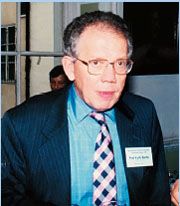
Keith Bartle is Emeritus Professor of Physical Chemistry and Visiting Professor in the Energy Centre at the University of Leeds, UK.
He was educated at the Bradford Technical College and obtained his B.Sc. equivalent in chemistry while working part-time as a laboratory technician. He then pursued a Ph.D at Leeds University, which was awarded in 1966 on his research in NMR. After postdoctoral appointments, which included an ICI Fellowship, Bartle joined the staff of Leeds University (1969) where he was successively Instructor and Senior Lecturer and became a Professor in 1991. His teaching focused on the teaching laboratories, where he pioneered computer-assisted learning and helped establish a new degree course in chemistry with analytical chemistry.
Bartle began work on capillary chromatography in 1958 and this topic continues to fascinate him. He worked with Milos Novotny in Stockholm in 1969 and in Milos’s own laboratory at Indiana University in 1973, focusing on developing applications for GC–MS.
A fruitful collaboration with Milton Lee at Brigham Young University in 1980 convinced him to work on defining the chemistry and physics underlying the preparation of reliable columns for capillary GC.
The resulting availability of these columns from the early 1980s advanced developments in the radically new area of multidimensional chromatography. Bartle collaborated in his Leeds laboratory with Luigi Mondello and Paola Dugo from the University of Messina to develop coupled liquid chromatography–gas chromatography (LC–GC) methods for the analysis of foods and fuels, and with Ally Lewis on GC×GC (two-dimensional coupled gas chromatography for atmospheric analysis).
With the help and cooperation of Peter Myers and the late Tony Clifford, Bartle began work on supercritical fluids in the mid-1980s and found that many elegant separations could be achieved by open-tubular column SFC in a wide variety of areas, especially with new detectors, including Fourier Transform Infrared (FTIR)- and Raman spectroscopy.
In parallel, and with Tony Clifford, Bartle next explored the theory underpinning retention in SFC and extraction with supercritical fluids especially solubility in supercritical fluid CO2. They also proposed a theory of preparative- scale SFC.
With colleagues from Leeds Bartle constructed a hybrid microcolumn GC/SFC/HPLC instrument (a “unified chromatograph”) in the 1990s, which allowed switching between the various modes.
Bartle’s research programme has produced 43 graduates, and he still has an active interest as Visiting Professor at Leeds University (2002–present). This programme has resulted in three books and over 400 research papers (21 in separation science, and 25 in other areas since 2002). His work was recognized by the award of the Franck Medal of the International Tar Conference (1986), the Jubilee Medal of the Chromatographic Society (1990), the M.J.E. Golay Medal (2002), and the Knox Medal of the Royal Society of Chemistry (2016).
Keith and Christine Bartle have been married for over 53 years with two children and four grandchildren.
Keith’s major interest outside family and chemistry is cricket and helping maintain the cricket field that adjoins his home.
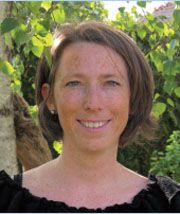
Caroline West received her Ph.D. in analytical chemistry in 2005 from the University of Paris-South in France. She was appointed an assistant professor in analytical chemistry at the University of Orléans, France, and an associate professor from 2010. At this university, she teaches separation science and is in charge of the Master’s degree programme in analytical chemistry.
She is an elected member of the Research Council of the University of Orleans, an elected member (Secretary) of the local section of the French Society for Chemistry (SCF), and a member of the French Association for Separation Science (AfSep).
Her research interests lie in fundamentals of chromatographic selectivity, both in the achiral and chiral modes mainly in SFC, but also in HPLC. Her work is essentially devoted to improving the understanding of chromatographic separations to assist method development. For this purpose, she relies on extensive experiments and chemometric strategies.
She has received the LCGC Award of Emerging Leader in Chromatography in 2015. Since 2015, she has been a Junior Member of the Institut Universitaire de France (IUF), a French service of the Ministry of Higher Education that distinguishes a small number of professors for their research excellence, according to their international recognition.
She is the author of over 60 peerâreviewed publications (most of them on SFC), and has presented over 50 talks in congresses and seminars. She is a member of the editorial advisory board of LCGC North America and Chromatographia. She is also very active in peer-reviewing papers for several chromatography journals.
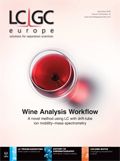
New TRC Facility Accelerates Innovation and Delivery
April 25th 2025We’ve expanded our capabilities with a state-of-the-art, 200,000 sq ft TRC facility in Toronto, completed in 2024 and staffed by over 100 PhD- and MSc-level scientists. This investment enables the development of more innovative compounds, a broader catalogue and custom offering, and streamlined operations for faster delivery. • Our extensive range of over 100,000 high-quality research chemicals—including APIs, metabolites, and impurities in both native and stable isotope-labelled forms—provides essential tools for uncovering molecular disease mechanisms and exploring new opportunities for therapeutic intervention.
New Guide: Characterising Impurity Standards – What Defines “Good Enough?”
April 25th 2025Impurity reference standards (IRSs) are essential for accurately identifying and quantifying impurities in pharmaceutical development and manufacturing. Yet, with limited regulatory guidance on how much characterisation is truly required for different applications, selecting the right standard can be challenging. To help, LGC has developed a new interactive multimedia guide, packed with expert insights to support your decision-making and give you greater confidence when choosing the right IRS for your specific needs.

.png&w=3840&q=75)

.png&w=3840&q=75)



.png&w=3840&q=75)



.png&w=3840&q=75)









